Best Disability Insurance For Personal Trainers And Fitness Instructors | We Discuss Plan Options And Cost
Updated: April 12, 2024 at 9:39 am

Personal trainers and fitness instructors probably don’t think of disability insurance, right?
You are healthy, and you probably think a disability can’t happen to you.
Sure, you are probably healthy. However, have you ever thought about what could happen if you could no longer do your job?
Have you ever thought about what would happen if you became sick, ill, injured, and disabled?
How would you pay your bills if you could not work?
In this article, I discuss 3 great reasons why personal trainers and fitness instructors need disability insurance.
I also go into detail about what constitutes a great policy, discuss underwriting, discuss cost, and touch on the best policies for your occupation.
This is a complete guide for personal trainers and fitness instructors on disability insurance.
- What Is Disability Insurance?
- 3 Great Reasons Why You Need Disability Insurance
- The Characteristics Of A Strong Policy
- Best Disability Insurance
- How Carriers Underwrite Your Application
- Estimated Premiums Of Disability Insurance
- Options If You Are A Business Owner
- Final Thoughts About Disability Insurance
Let’s jump right into discussing what is disability insurance and why you probably need it.
What Is Disability Insurance?
Disability insurance is, simply, a type of insurance that pays you a dollar benefit if you can’t work due to illness or injury. It replaces part of your income.
Do you need disability insurance?
Many personal trainers and fitness instructors tell me, “no”, but if you:
- Make money, and
- You use that money to pay your mortgage, groceries, and other needs, and
- If you and your family would be in a tough financial situation if you could not work, then:

It is really that simple.
Essentially, if you will struggle to pay the bills upon an illness or injury, you probably need disability insurance.
It’s Paycheck Protection
 Think of disability insurance as “paycheck protection”.
Think of disability insurance as “paycheck protection”.
Think about how you are able to pay for things.
We have our house, cars, vacations, luxury items, and necessities. Think of all that.
How do you get the money to pay for all of that?
From working, you ask?
Yes. All of that is derived from your ability to work and earn an income.
Conversely, all of that is potentially gone with your inability to work and earn an income.
How much benefit do you receive if you can’t work? That depends on how much you make and your income. Depending on your situation as a personal trainer, carriers might insure up to 60% of your gross salary. If you are self-employed or a 1099-contractor, carriers will insure maybe 80% of your net income.
Wait, John. Why don’t I get 100% of my income, you ask?
Good question. Carriers rarely insure 100% of your income or salary. Why? Well, there are a couple of reasons:
- If you receive a benefit, your benefit is income tax-free. So, you pay no taxes on your benefit, and
- To incentivize you back to work
Human nature tells us that if we receive 100% of our income, we probably don’t want to go back to work, right?
There are ways to potentially obtain 100% of your income. It is outside the scope of the article. If you want to learn more, feel free to reach out to us.
Disability Insurance Is Your Spare Tire
As a final thought here in this section, think of disability insurance as a “spare tire”.
You really don’t think of your spare tire (or AAA) until you really need it, right?
And, when you do, you are thankful you have that spare tire or the AAA membership.
A temporary tire replaces your flat. You are back on the road, and you get your other tire repaired.
Disability insurance is no different, except it gets you back on the road of your life. (Related: see the 5 reasons why you need disability insurance.)
3 Great Reasons Why Personal Trainers and Fitness Instructors Need Disability Insurance
Now that we know what disability insurance is, let’s talk about the 3 reasons why personal trainers and fitness instructors need disability insurance.
Wait, John, you say. I am not going to get disabled.
Is that right? How do you know? I know, generally speaking, most personal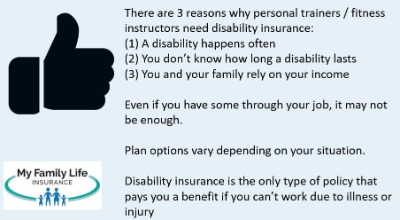 trainers and fitness instructors are healthy. If you did know, however, you could play the lottery and enjoy your winnings. You can quit your job as a fitness instructor. Know what I mean?
trainers and fitness instructors are healthy. If you did know, however, you could play the lottery and enjoy your winnings. You can quit your job as a fitness instructor. Know what I mean?
The fact is, you can be the healthiest person on earth and diagnosed with cancer the next day. It happens to thousands of individuals every day.
This unknown brings us to our first reason.
Reason #1: A Disability Happens Anytime And To Anyone
The chance of disability for all of us is really high, even for fitness instructors and personal trainers. According to the Social Security Administration, an adult worker has a 1 in 4 chance of experiencing a long-term disability.
That is higher than common scenarios such as passing away from cancer (1 in 7) and even death from a car accident (1 in 107).
Remember, a disability is any injury or illness that prevents you from doing your job. So, a disability for a fitness instructor or personal instructor could be a:
- Broken hand
- Cancer diagnosis
- Back injury
- Head injury
- Multiple sclerosis diagnosis
- Torn ACL
- Loss of eyesight
- Complete loss of your voice
- Stroke
The list goes on and on…
No one plans for a disability. Disabilities do not discriminate. They do not care about your ethnicity, job, or how much you make. It occurs when you least expect it.
Tiger Woods knows this. Recall his horrible car accident. He left his hotel at 7AM. Around 7:10, he became disabled. His job is golfing, and he can’t do that.
The difference between Tiger Woods and us is he has millions to live off of. We don’t.
What if you faced a situation where you could no longer work? That is a disability.
However, a disability isn’t only a severe accident. It can be a cancer diagnosis, an ALS diagnosis, weird nerve pain shooting through arms that prevents you from using your hands.
Any type of illness or injury that prevents you from doing your job is a disability.
What would you do if you could not bring in an income to support your family?
Now, do you see the importance of disability insurance?
Reason #2: A Disability Could Last A Long Time
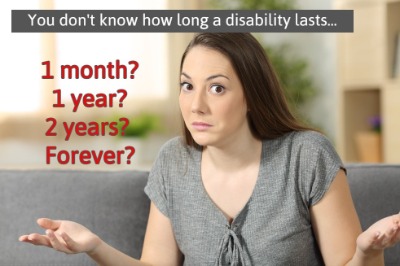 Disabilities could last a while. I am aware of the statistics floating around the internet. There is one that suggests that the average disability lasts almost 35 months. Possibly. The claims departments I speak to suggest, on average 18 months to 24 months.
Disabilities could last a while. I am aware of the statistics floating around the internet. There is one that suggests that the average disability lasts almost 35 months. Possibly. The claims departments I speak to suggest, on average 18 months to 24 months.
Nevertheless, could you and your family survive financially from 1.5 years to 3 years – or more – if you can’t work?
Some disabilities are longer. Disabilities from mental illnesses or alcohol/drug abuse can last years. How do you know these unfortunate situations won’t happen to you?
Conversely, some are shorter. We just had a client who came off a claim from Leukemia. He was out of work for almost 11 months. It doesn’t matter what his occupation is. A disability can happen to any one of us.
The moral of this section is you really don’t know. Disability insurance protects you from this unknown. It pays you a benefit, which in turn you can focus on your rehab, treatment, and family. Which, brings us to our next section.
Reason #3: More Important People Rely On You
Here’s another important reason. You may think your clients are the most important people. Who can be more important than them, you think. They pay my income.
True. They do. Let’s be honest, though, your clients don’t love you as your family loves you. By far, if you have a family, your spouse and children rely on you more than you think. They love you more than anything.
loves you. By far, if you have a family, your spouse and children rely on you more than you think. They love you more than anything.
If you are disabled, without disability insurance, there are tough questions that need answering.
- Would you and your family be able to continue your standard of living without your income? If not, what changes would need to be made?
- Would your spouse have to work or work more?
- Would you need to sell your home to make ends meet? This happens way more than you think (link)
- Who could be flexible with the children?
- Would you have the money to hire someone to take care of the kids? The tough questions can go on and on.
I call disability the destroyer of dreams. Your future and family dreams could be destroyed. I’m being honest here.
They don’t have to, though. With disability insurance, you have peace of mind knowing that you have a plan – and income – in place should the unexpected happen.
Remember the spare tire/AAA analogy. That is the sole purpose of disability insurance: to provide payments to you in case you can’t work. Then, you can focus on rehab / getting better and getting back to work.
The Elements Of A Strong Disability Insurance Policy For Personal Trainers And Fitness Instructors
Hopefully, we have made a great case showing that personal trainers and fitness instructors need disability insurance.
I’m ready to enroll now, John, you say.
Sounds great. First, though, let’s discuss the characteristics that make a strong policy.
You see, there are many policies that offer limited benefits.
You don’t want to mess with those policies. The worst thing that could happen is you file a claim, expect a payout, and don’t receive one.
So, let’s first discuss the basic elements needed in any disability insurance policy for personal trainers and fitness instructors. We will then discuss additional insurance options and riders.
Disability Insurance Policy Basics
I speak to professionals, including personal trainers and fitness instructors, about disability insurance every day. There are 2 major sources of confusion that these professionals hear from elsewhere. These confusing components are, essentially, “the basics”, but if you get these wrong, you could be in for a surprise when it comes time to make a claim.
The first is the waiting period or elimination period. In terms of disability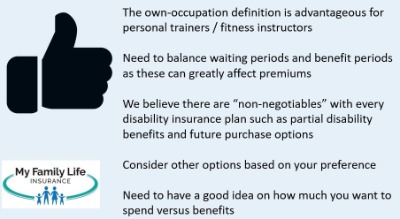 insurance, it is not the period of time before your policy is in effect. That is correct for other types of insurance, but not for disability insurance.
insurance, it is not the period of time before your policy is in effect. That is correct for other types of insurance, but not for disability insurance.
The elimination period is the length of time – a waiting period – that elapse before you are eligible for disability benefits. It happens upon a claim. For example, a 90-day elimination period means your benefit period will begin after 90 days of disability. On the 91st day, you are eligible for benefits. Typically, you receive your first benefit 30 days after that.
This means you need to have adequate savings to carry you and your family until benefits begin.
The second is the benefit period. The benefit period starts when you are eligible for benefits and lasts until the end of the benefit period or if you return back to work, whichever occurs first. It is not the maximum timeframe that your policy exists. As long as you pay the premiums, you will have the policy until age 65 or 66 – at retirement age.
Typically, the maximum benefit period for personal trainers and fitness instructors is a 5-year benefit period. A longer benefit period might be possible.
Remember, the average disability claim is 35 months (internet stats) or the 18-24 months (from claims departments).
The Disability Definition Matters…
The definition of disability matters. You generally want some type of “own occupation” definition.
There are two “degrees” of the own occupation definition: “true” own occupation and the “modified” own occupation definition. (There are other own occupation definitions, but these are the two most common.)
Here’s what they each mean. The “true” own-occupation definition means:
- you will receive a disability benefit based on your inability to do your job (as a personal trainer), AND
- also work simultaneously in another job for an earned income (should you decide you can).
In other words, you can continue to work in another occupation while receiving disability benefits for the inability to do your job as a personal trainer.
So, if you can’t use your hands, but you can greet people at Walmart, you will receive disability benefits in addition to your earnings as a Walmart greeter.
Modified own occupation is a bit different. You will receive a disability benefit based on your inability to do your job. However, you can’t work in another job. So, if you are working as a Walmart greeter, you won’t receive disability benefits under the modified own occupation definition. This is a good definition, too.
Finally, there is the stringent “any” occupation definition. This means, simply, if you can work in any gainful occupation (for which you are reasonably suited, considering your education, training, and experience), you’ll be denied benefits. So, under this definition, you won’t receive a disability benefit based on your education and experience as a personal trainer because the insurance carrier says you can work as a Walmart greeter.
The plans we work with contain the favorable true own occupation definition for personal trainers. Moreover, you can align this definition to match some or all of your benefit period.
2 Important Disability Insurance Elements For Personal Trainers And Fitness Instructors
Personal trainers and fitness instructors should obtain some type of own occupation definition. However, a comprehensive policy should contain the following 2 additional elements.
These 2 elements, in addition to the own occupation definition, creates a formidable disability insurance plan.
Residual or Enhanced Partial Disability Benefit
The disabilities we have implied so far are total disabilities. In other words, you can’t work at all.
However, many disabilities start out or end as a partial disability. What if you can work, just not full time?
This is where you want partial disability benefits. A plan that offers partial disability benefits pays a pro-rated benefit of the time or work lost because of the partial disability.
Many policies offer an enhanced partial disability benefit. This provision pays a benefit if you work in your occupation in a part-time basis due to an illness or injury.
Usually, the amount of disability income you receive is a percentage of your total monthly disability benefit. For example, let’s say you work 3 days a week now and therefore experience a 40% income loss. If your monthly disability benefit is $4,000, you will receive $1,600 ($4,000 X 40%). This is a simple example to illustrate.
However, beware. Many policies state they have partial disability benefits. But, when you read their definition, it states that partial benefits are paid after a period of total disability.
This means if you are only partially disabled (i.e. you can still work, but not full-time), you will not receive any benefits until you have met the carrier’s requirements of a total disability first.
That could be years before you become totally disabled. Take multiple sclerosis or carpal tunnel syndrome. Both of these conditions may start as a partial disability. However, if you don’t have adequate partial disability benefits, you won’t receive anything until you are totally disabled.
This scenario underscores the importance of partial disability benefits.
Proper partial disability benefits circumvent the total disability requirement and allow you to receive benefits immediately (after you satisfy the elimination period) if you are partially disabled.
Guaranteed Purchase Option
Let’s say you purchased a disability insurance policy 5 years ago. Your salary is now $25,000 more than what it was when you applied. You are now underinsured if you make a claim.
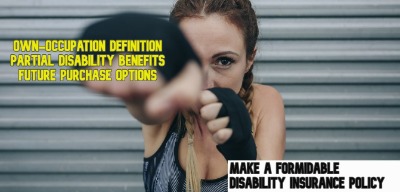 What do you do?
What do you do?
If you have a guaranteed purchase option (AKA future purchase option), you can purchase more disability insurance with no evidence of health insurability. In other words, you don’t need to go through underwriting again.
That means if you now have type 2 diabetes or Multiple Sclerosis (for example), you can still purchase more disability insurance. How great is that?
You just need to prove your income increased, usually through a tax return or your W-2 stub.
I’ve seen many policies where this option is left off. If you don’t include this option at the time of application, you will then need to reapply for a new policy if you want more disability insurance. If your health changed in any way, you could face benefit limitations, higher premiums, or declined altogether.
You can see how important this option is.
Optional Disability Insurance Riders
We have discussed the 3 important elements of a disability insurance policy for personal trainers and fitness instructors. In my opinion, these are generally “non-negotiable” elements.
However, you can add optional riders at an additional cost to your policy to best fit your needs and budget.
Disability insurance is very customizable. You can make it as cheap or expensive as you want. (However, as you will see, you don’t need an “Ashton Martin” plan to adequately protect yourself).
If you want more benefits, expect to pay more in premium. Think of it as a seesaw. The more benefits you want, the higher the premiums.
Some popular rider options for personal trainers and fitness instructors include:
Return of Premium Rider: You will receive the premiums you paid back if you never make a claim. This option is more beneficial for younger applicants.
Retroactive Injury Benefit Rider: Pays additional benefits from the date of disability due to injury if disability occurs within 30 days of the injury and continues through the elimination period.
Activities of Daily Living Rider: This rider pays an additional benefit if you can’t perform two or more of the activities of daily living. Additionally, it will pay if you are cognitively impaired. This condition is a catastrophic disability.
Accident Plan: pays an indemnity benefit (i.e. fixed dollar benefit) if you are hurt or injured and go to urgent care or the ER.
Mental/Nervous/Drug/Alcohol Extension: Most carriers provide a 2 year benefit period only for disabilities caused by mental or emotional disorders (like depression) or by drug/alcohol abuse. This option extends the 2 year benefit period to your contracted benefit period.
The Best Disability Insurance For Personal Trainers And Fitness Instructors
You are probably wondering who we like to work with. First, we work with many disability insurance carriers. So, we are sure we can find one that meets your needs and budget.

Also, not all carriers insure personal trainers or fitness instructors. See the snapshot out of an underwriting guide of a popular carrier.
There is only a handful that will properly insure the personal trainer/fitness instructor occupation. These carriers include:
- Illinois Mutual
- Assurity
- Mutual of Omaha
They offer value-added benefits to enhance your coverage. Additionally, they are on the more affordable side when it comes to premiums. We will talk about the cost later. However, it is important to first level set and understand how disability insurance carriers underwrite your application. That is the basis of how they derive your premium.
How Disability Insurance Carriers Underwrite Your Application
It’s important to understand how disability insurance carriers underwrite your application. It is how the carrier determines the premium.
Oh, I just went through the life insurance process. I know how it works, you say.
Great. But, disability insurance underwriting is completely different.
Carriers aren’t insuring your mortality. They are insuring your morbidity. In other words, the risk of a disabling accident or illness and paying you a percentage of salary or income.
So, carriers look at the following attributes in an application.
When it comes to underwriting, carriers look at your:
- Age
- Health
- Income / Salary
- Occupation
- Other hazards and lifestyle situations
Age is a factor. The older you are, the more expensive the policy – all things being equal, of course. This is why you want to start your policy as soon as possible.
Obviously, your health matters. If you have a chronic illness or had a severe injury in the past, likely that illness or injury won’t be covered. Additionally, carriers can limit benefits based on any health condition.
As we mentioned before, carriers insure a percentage of your salary. This percentage is usually 60% of your gross salary.
Your occupation matters as well. All the disability insurance carriers classify your occupational disability risk. The classification table is usually a 1 to a 5 (or 6 with some carriers). An occupation with a class 1 is most risky while an occupation with a class 5 is least. For example, carriers classify a construction laborer at a 1 and an accountant at a 5.
Usually, carriers classify the personal trainer occupation at a class 2. Sometimes, higher classifications are available.
Finally, carriers also consider other situations and lifestyle choices like hazardous hobbies. Do you like to rock climb? If so, that hobby will be excluded from your policy.
What Do The Carriers Do With The Information?
The underwriters review all this information and make an approval decision or not. They routinely look up your medical background in the MIB, prescription drug databases, driving records, tax records, etc.
As we discussed, certain situations may limit benefits, benefit periods, and/or waiting periods. They may also increase premiums to compensate for an increased disability risk.
Nevertheless, if your benefits are modified in any way, it still makes sense to purchase the policy. We discuss more in our underwriting.
How Much Does Disability Insurance Cost Personal Trainers and Fitness Instructors
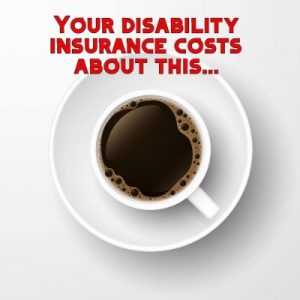 That’s the $64,000 question. Well, the premiums you pay are a function of everything we discussed above.
That’s the $64,000 question. Well, the premiums you pay are a function of everything we discussed above.
However, disability insurance is not incredibly expensive.
Depending on your situation, disability insurance costs between $1.00 and $3.00 per day. Sometimes it is more; sometimes it is less.
The cost is about the cost of a cup of coffee at your favorite coffee shop.
If you can afford a cup of coffee, or lunch, you can certainly afford disability insurance.
If you do the math, that is 2 cents for every dollar you earn.
Disability insurance costs around 2 cents for every dollar you earn. Think about that.
For example, a woman aged 40, making $50,000 annually could have a $2,500 monthly benefit, own-occupation definition policy for around $72 per month or $2.40 per day.
Again, the cost could be more or less depending on various factors.
Other Disability Insurance Options For Personal Trainers And Fitness Instructors
If you are a business owner, then you have other options available to you and protect what you’ve worked so hard for.
A business overhead expense policy pays a benefit to you to pay your business expenses.
It is very similar to an individual policy, except:
- Up to a maximum 2 year benefit period
- Limited “additional” options
- Usually, cheaper than an individual policy
- Premiums are tax-deductible
Typically, our personal-trainer business owner clients use the business overhead expense policy to pay for:
- Rent
- Taxes
- Employee salaries
- Inventory
- And, more (see the excerpt)
Next, we have disability insurance that protects business loans.
Let’s say you purchased a whole bunch of new exercise equipment. What happens if you are disabled? Will you be able to make the loan payments?
If no, that is where disability insurance comes in. There is a special type of disability insurance policy that protects your business loans.
You’ll want a separate policy to protect these loans. Remember, Your individual policy is to help you and your family’s everyday needs like your mortgage and groceries. Your business overhead expense policy is really designed to pay your rent, salaries, etc. The business loan protection policy (as sometimes called) protects (and pays) your loan payment to the lender. You actually don’t even write the check. The carrier typically pays the lender directly.
Final Thoughts About Disability Insurance For Personal Trainers And Fitness Instructors
We hope now you have a solid idea of why personal trainers and fitness instructors need disability insurance.
Confused? Don’t feel that way. We’re here to help educate you and protect your income and future.
Don’t know where to start? Use this disability insurance needs analysis worksheet. Follow the instructions; it is rather easy to fill out (we at My Family Life Insurance try to make understanding insurance easy).
Next, feel free to reach out to us for our assistance or a quote. Or, use the form below. We only work for you, your family, and your best interests only. We have helped many personal trainers and fitness instructors secure the right disability insurance for their specific situation, giving them and their families peace of mind. I’m confident we can help you, too.
Learn More
Are you interested in learning more about the information in this article? Please fill out the form below, and we will email you additional information or give you a call. We always work in your best interest. By entering your information, you are providing your express consent that My Family Life Insurance may contact you via e-mails, SMS, phone calls, or prerecorded messages at any phone number(s) that you provide, even if the number is a wireless number or on any federal or state do-not-call list. Additionally, you understand that calls may be placed using automated technology, and that consent is not a requirement for purchase. Your information will NOT be sold and will remain private. However, you may opt out at any time. We respect your privacy first and foremost. By contacting us, you agree to receive text messages from our number (800) 645-9841. If you no longer wish to receive text messages, you may opt out at any time by replying "STOP".
2 thoughts on “Best Disability Insurance For Personal Trainers And Fitness Instructors | We Discuss Plan Options And Cost”
Comments are closed.
Thanks for this informative blog. I am a business owner and a personal trainer for special needs. I am running a successful special needs gym in the USA where I provide fitness training to special children and adults. I agree with your point that insurance is important. Can you provide some more information according to my business?
Hi Daniel,
Thanks for reaching out to us. I’ll send you some information directly via email. If you would like our help, please reply back to the email. We are happy to help.
John